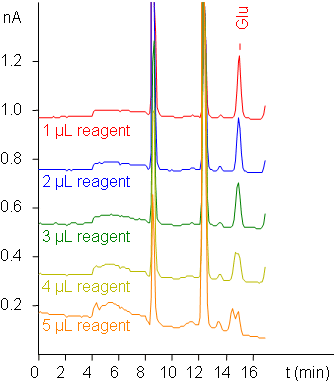GABA, Glu, bad peak shape, loss of signal
Applies to
ALEXYS system for GABA and Glu (213_019).
Summary
Bad peak shape, or loss of signal in GABA-Glu analysis.
Cause
Composition of the final derivatization mix is not correct. Possible cause:
- sample is acidified before analysis, or
- mixing ratio of sample:reagent is not optimal
- other cause
This (1, 2) is resulting in pH change in derivatization mix. Derivatization reaction is incomplete.
Remedy
The mix ratio of reagent with sample is important as it affects the composition of the final derivatization mix:
- Too much reagent: due to high pH of sample bad peak shape is seen in chromatogram (even splitting of peaks, see figure below).
- Not enough reagent: incomplete reaction, loss of signal
- Sample contains strong (acidic) buffer: incomplete reaction, loss of signal
If necessary, run a few chromatograms to see how the mix ratio affects chromatography and peak height. For the GABA-Glu application it is important to keep the reagent in a darkened vial (cover with aluminum foil for instance). A gradual loss of signal may be observed with the aging of the reagent, which should be prepared freshly on a regular basis (once every 2 days). Also, the sodium sulfite must be prepared fresh (not from a stock solution).

Fig. 1. An example of mixing 20 µL standard (Glu, 250 nmol/L ) with different volumes of OPA reagent. Too much reagent results in peak splitting, bottom trace.